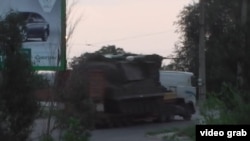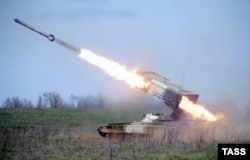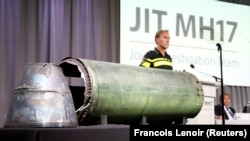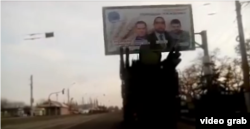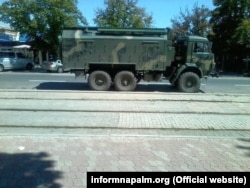Last week a group of top officials with Russia's ruling party -- including its general secretary, Andrei Turchak, a deputy chairman of the upper house of parliament -- appealed to the Kremlin to provide advanced weaponry to Moscow-backed separatist forces waging war against Kyiv in parts of eastern Ukraine.
"Russia should provide [the separatists who hold parts of the Luhansk and Donetsk regions] with the necessary assistance in the form of the supply of certain types of weapons to increase their defensive capability," Turchak said, claiming without evidence that Kyiv was planning an offensive in the region, where the ongoing war has killed more than 13,000 people since 2014.
Kremlin spokesman Dmitry Peskov on January 27 responded by saying that such proposals "underscore the intensity of the problem" and that providing weaponry would be "something new," asserting that Moscow has never sent such aid into Ukraine before.
Peskov's statement reflects Moscow's long-standing claim that it is not a party to the conflict in the region known as the Donbas. The claim has been rejected by Kyiv and the West and undermined by strong evidence that Russia has sent troops, weapons, and other kinds of military support into the area.
When it comes to arming the separatists, open-source investigators, journalists, and activists have been documenting the presence of sophisticated Russian weaponry in the areas under their control since the beginning of the conflict.
Using such information, the joint investigation team (JIT) looking into the downing of Malaysia Airlines flight MH17 over eastern Ukraine in July 2014 determined in 2016 that the passenger jet was shot down by a Buk antiaircraft system that had been brought to Ukraine from Russia the same day and then returned to Russia -- minus one missile -- after the jet was shot down, killing all 298 passengers and crew.
Ukrainian military analyst Mykhaylo Zhirokhov told RFE/RL that Russia has provided such equipment since the beginning of the conflict, although it generally sends older Soviet-era weaponry that fighters could plausibly say was captured from the Ukrainian military. Modern equipment, he said, is handled only by Russian military personnel operating covertly inside Ukraine.
"Those Russian groups...are armed with contemporary weapons," Zhirokhov said. "But only Russian military personnel get them. There is not a single piece of modern equipment under the control of the [separatist] armed formations."
Zhiriokhov sees the latest Russian talk about providing military equipment to the separatists as "an effort to legitimize the presence of the Russian Army" in the Donbas. "They aren't going to provide any modern weapons to the fighters," he emphasized. "As far as I understand, this is the basic position of the political and military leadership in Russia."
Nonetheless, the catalogue of modern Russian military equipment documented in the separatist-controlled areas since 2014 is voluminous.
Below is a rundown of many of the findings that online investigators -- most of whom are affiliated with InformNapalm, a research group that was founded by a Ukrainian journalist and a Georgian military expert in 2014 -- have reported:
Armored Vehicles
- A T-72C1 tank was spotted in the Luhansk region in 2016.
- A T-90A tank (2006 model year) was seen in the Donbas in 2016.
- T-72B, T-72BA, and T-72B3 tanks were sighted in the Debaltseve area in 2015 and in Luhansk in 2014.
- The armored transporter BT-LB BM/K for towing and moving troops was documented in the Luhansk region in 2016.
- An upgraded BMD-2 amphibious vehicle with PL-1-01 advanced laser infrared searchlight was seen in Donetsk in 2017.
- BTR-80 and BTR-82A armored personnel carriers were spotted in Makiyivka in 2016, in Donetsk in 2017, and in the Luhansk region in 2016.
Artillery
- A SAU 2S7 Pion 203-millimeter, self-propelled artillery was documented near Makiyivka in 2015.
- SAU Msta-S 152-millimeter, self-propelled howitzer was seen near Debaltseve in 2015.
- An RS30 2B26 Grad modernized 122-millimeter, multiple-launch rocket system was documented by observers from the Organization for Security and Cooperation in Europe (OSCE) in the Donetsk region in 2020.
- An RS30 9K58 Smerch 300-millimeter, long-range multiple-launch rocket system was spotted near Makiyivka in 2015.
- A TOS-1 Buratino heavy multiple-launch thermobaric rocket system was documented by OSCE monitors in the Luhansk region in 2015.
Antiaircraft Systems
- A ZRK Buk-M1 surface-to-air missile system was documented by the international investigation into the downing of the MH17 passenger airliner in the Donetsk region in July 2014.
- A 96K6 Pantsir-S1 antiaircraft missile-artillery complex, designed for defense against cruise missiles and smart weapons, was spotted in Luhansk in 2015.
Observation Drones
- The Granat-1, Granat-2, Granat-4, Forpost, Orlan-10, Eleron-3, Zastava, and Takhion observation drones have been located and shot down throughout the Donbas during the conflict.
Electronic-Warfare Vehicles
- An R-330Zh Zhitel was documented in Svitlodarsk in 2016, near Makiyivka in 2015, and in the Luhansk region in 2019.
- An R-378B Borisoglebsk-2 was spotted in the Luhansk region in 2016.
- A Repellent-1 electronic-warfare complex with drone was sighted in the Debaltseve area.
- A 1L269 Krasukha-2 radar-jamming system was documented by OSCE monitors near Chornukhine in the Luhansk region in 2018.
- An RB-341B Leyer-3 cellular-communications jamming system was spotted in Donetsk in 2016 and Chornukhine in 2018.
- An RB-109A Bylina electronic-warfare command post was seen near Chornukhine.
- A 1RL243 Rubicon electronic-monitoring post was seen near Yasynuvata in the Donetsk region in 2016.
- An RB-636AM2 Svet-KU mobile radio command post was seen in the Donetsk region in 2020 and in Luhansk in 2016.
- An SPR-2M Rtut-BM radio-signal-jamming system was seen in Donetsk in 2016 and the Luhansk region in 2016.
- An R-934UM aviation-communications-jamming system was seen near Luhansk in 2016.
Other Equipment
- A 9K129 Kornet portable anti-tank weapon was documented near Starobesheve in 2014.
- A Shmel man-portable rocket-assisted flamethrower was captured by Ukraine's SBU intelligence agency in the Luhansk region in January 2022.
- NVU-P Okhota noncontact land mines were captured in the Luhansk region in 2020.
- A POM-2 antipersonnel fragmentation land mine killed a civilian in the Luhansk region in 2021.
- A Krasnopol guided artillery shell was recovered following an attack on the settlement of Novoluhanske in 2019.




